In this episode we travel to a world without bees. And not just honey bees, all bees.
You’ve probably heard a lot of doom and gloom predictions about what might happen if honey bees went extinct. Mass famine! The end of coffee! World economic collapse! But is that all true? (Probably not.) And how likely is a honeybee extinction anyway? (Extremely unlikely.) Plus, what about all the other bees in the world? We ponder these questions and more in this episode.
To walk us through what might happen to agriculture if bees went away, I talked to Marcelo A. Aizen, a researcher who studies plant pollinator interactions. His research suggests that the loss of honeybees might not be as dire as everybody claims. And to talk about the more neglected bees out there, I called up Elaine Evans, a professor at the University of MInnesota’s Bee Lab, and Paige Embry, the author of the forthcoming book Our Native Bees: North America’s Endangered Pollinators and the Fight to Save Them.
Plus, a little bonus “what if” at the end, featuring cartoonist Dean Yeagle, the man who drew the original Honey Nut Cheerios bee.
Further reading:
- How much does agriculture depend on pollinators? Lessons from long-term trends in crop production (PDF)
- How to befriend bumblebees
- What if bees went extinct?
- Why bees are disappearing
- Citizen Science: Bumble Bee Surveys
- Has Anybody Seen the Franklin’s Bumblebee?
- Franklin’s Bumblebee Still Elusive
- The Old Man and the Bee
- Wallace’s Giant Bee
- Honey Nut Cheerios Mascot Goes Missing as Brand Addresses Declining Bee Populations
Flash Forward is produced by me, Rose Eveleth. The intro music is by Asura and the outtro music is by Hussalonia. The future voice this episode was provided by Mike Rugnetta. The episode art is by Matt Lubchansky.
If you want to suggest a future we should take on, send us a note on Twitter, Facebook or by email at info@flashforwardpod.com. I love hearing your ideas! And if you think you’ve spotted one of the little references I’ve hidden in the episode, email us there too. If you’re right, I’ll send you something cool.
And if you want to support the show, there are a few ways you can do that too! Head to www.flashforwardpod.com/support for more about how to give. But if that’s not in the cards for you, you can head to iTunes and leave us a nice review or just tell your friends about us. Those things really do help.
That’s all for this future, come back next time and we’ll travel to a new one.
▹▹▹▹▹▹▹▹▹▹▹▹▹▹▹▹▹▹▹▹▹▹▹▹▹▹▹▹▹▹▹▹▹▹▹▹▹▹▹▹▹▹▹▹▹▹▹▹▹▹▹▹▹▹▹▹▹▹▹▹▹▹▹▹▹▹
TRANSCRIPT
Rose: Hello and welcome to Flash Forward! I’m Rose and I’m your host. Flash Forward is a show about the future. Every episode we take on a specific possible… or not so possible future scenario. We always start with a little field trip to the future, to check out what’s going on, and then we teleport back to today to talk to experts about how that world we just heard might really go down. Got it? Great!
This episode we’re starting in the year 2073.
[YouTube Music]
YouTube Host: Hey guys! Melissa Bhramari here, and you’re watching my YouTube channel Pollination Nation. If you like what you see, don’t forget to subscribe! Just click the button right here. Okay! On to the video!
Today we’re going to review hand pollination of … Vanilla planifolia. Tadaaaaa.
Right so normally this plant, like every plant we’ve talked about on this channel, would be pollinated by bees. But… womp womp, no more bees. So here we are! Pollinating! It’s fun! And also worth it if you want vanilla. Which I bet you do!
So the vanilla planifolia is actually a type of orchid, which is very cool. See how pretty it is? One cool thing about vanilla plants is that they’re orchids, but they actually grow as vines. So you see how my little guy here is on this stick, and it’s all viney. That’s the normal way it grows.
Another cool thing about vanilla flowers is that each flower only opens for one day. ONE DAY. So, you miss it, and you’ve gotta wait another 364 days. No good! So keep an eye on this bad boy.
Okay so here’s what you’re going to need for this pollination situation: a toothpick. That’s it! So easy. Who needs bees! Not us, we’ve got our handy toothpick. Hello little buddy! Ready to pollinate? Great!
So back in the day, this pollination would have been done by a bee called the Melipona bee. We don’t have those anymore, so we’re stuck with our handy little toothpick right here. I put little wings on it just to make the flower feel better. See flower, everything is okay! You’ve got me!
So what you do first is pull this flower back here, and yeah, you’re going to have to rip the flower. Sorry buddy. So pull this part back, and find your little nub…. [fades out]
>>
Rose: Okay so today’s episode is about a world without bees. And when you think of a future without bees, most people think mostly about honeybees. Because honeybees are the ones that we can really easily point to as direct drivers of our economy, our food systems, and more. Plus, people have been worried about honeybees ever since they started abandoning their hives in 2006, a phenomenon that was eventually dubbed Colony Collapse Disorder.
So if you google “bee extinction” you actually get a lot of predictions for what would happen if honey bees went extinct. And those predictions, are pretty dire. They usually start with a list of all the products that we’d no longer get to enjoy.
YouTube Clip: Many fruits and vegetables will simply stop growing.
YouTube Clip: Carrots, apples, lemons, onions, melons, Brazil Nuts
YouTube Clip: Almonds, apples, avocados, cashews, blueberries, grapes, peaches, peppers, strawberries, tangerines, walnuts, watermelons
YouTube Clip: Apples, citrus fruits, asparagus and soy beans
YouTube Clip: And also you can say goodbye to any cotton clothes you have
YouTube Clip: And perhaps worst of all, coffee
YouTube Clip: Entire food chains and webs may be at risk.
Rose: Then they often get, well, kind of apocalyptic.
YouTube Clip: The cost of food will skyrocket
YouTube Clip: A monetary loss of over 14 billion dollars
YouTube Clip: More than fifteen billion dollars
YouTube Clip: Thirty billion dollars a year
YouTube Clip: Two hundred billion dollars
YouTube Clip: Malnutrition will be a huge problem, there will be a possible worldwide economic collapse, famines across the world
YouTube Clip: It’s thought that a world without bees just couldn’t sustain over 7 billion people
YouTube Clip: Humanity would be next
Rose: When you start looking into bee extinction, you often come across this thing that Einstein apparently once said quote “If the bee disappeared off the face of the Earth, man would only have four years left to live.” Except, Einstein almost certainly never said that.
Marcelo Aizen: This is a complete myth. I mean, Einstein never spoke about bees.
This is Marcelo Aizen
Marcelo: Okay I am an ecologist, a researcher, a scientist, and also a university professor. And I am based in the city of Bariloche in Patagonia surrounded by beautiful landscape of mountains, glacial lakes and very beautiful forest.
Rose: Marcelo studies the ways that pollinators, like bees, interact with plants that need to be pollinated. And a couple of years ago he started getting frustrated with some of the numbers that were constantly thrown around when it came to the importance of honeybees. Every paper seemed to start with the same little factoid:
Marcelo: The start of every paper on pollination started saying that bees are responsible for the production of one third of our food supply. Saying that without bees, agricultural production would be reduced by one third.
Rose: The problem is that Marcelo didn’t think that was exactly right.
Marcelo: even you know within the scientific communities we have our own myths, and that was one of those
Rose: You see the thing about those numbers you heard is that they ignore a really important fact about plants and pollination.
Marcelo: one problem with that estimate is that it doesn’t recognize that partial dependence on bees of many of those crops. That estimate is based on the assumption. That without peace both growth won’t produce anything.
Rose: Without bees, the logic goes, these plants wouldn’t be able to reproduce at all, and they would stop producing anything at all, and die. But that’s not true.
Marcelo: [many plant species including many crop produce produce seeds and fruits without being visited by pollinators, by this process of self-pollination.
Rose: Almost all of the plants that bees pollinate can actually pollinate themselves when there aren’t bees around. So it’s not true that things like cotton and apples and avocadoes would all die out without bees. They simply would be less efficient crops.
Marcelo: they won’t maximize the crop production without pollination.
Rose: And Marcelo wanted to figure out just how much less efficient they would be. To do that, he looked at data on the types of crops all around the world, and to what extent those crops were reliant on pollinators.
Marcelo: So you can, you know, multiply how much each of those crops produce times the degree of dependence on pollinators that can range from 0 percent to 100 percent and you will get an estimate that without any bees in the world, food production would be decreased by just 6 percent, 5 percent.
Rose: So without honeybees, global food production is reduced by five or six percent. Obviously that’s still a big impact, since global agriculture is worth billions and billions of dollars. But it doesn’t necessarily mean that you will never see another avocado or pair of jeans in the store again. It’s obviously not good, but it’s also not the same thing as mass crop extinction, famine and the end of humanity.
But one thing Marcelo found that I thought was really interesting, is that the if bees went extinct in, say, twenty years, the impact could be a lot bigger.
Remember that Marcelo scored crops on a scale of 0 to 100, where 0 is not dependent on pollinators at all, and 100 is totally dependent on pollinators. It turns out that farmers are moving more and more to the crops that are higher on that scale, more dependent on pollinators.
Marcelo: There is an increasing demand for those crops. Crops that depend on pollinators, apples, mangoes, pears, things like canola, oil palm. All those crops depend on pollinators. So in the last 50 years amount of land devoted to agriculture increased by 30 percent during the last 50 years. And most of the land was bolted to the cultivation of these kinds of crops.
Rose: So if things keep going this way, the impact of a bee extinction would actually get worse and worse.
But even then, Marcelo isn’t actually worried about bees going extinct and causing us all to starve. He’s worried that we’re going to destroy all our land planting these vast fields of crops that rely on bees and destroy the environment.
Marcelo: The problem is not the starvation of humanity, the problem in this environmental cost. That you are obliged to cultivate more and more and more to match a demand for these kinds of crops.
Rose: The good news, is that even though honeybees are certainly having some trouble right now, there’s actually no real danger that they will go extinct.
Elaine Evans: Honeybees, they’re not going to go extinct. The beekeepers are really good at raising more bees. They can make more honeybees happen for all of the other bees.
Rose: That’s Elaine Evans, a bee researcher at the University of Minnesota, and we’re going to hear more from her about the bees you actually SHOULD be worried about after the break. But first, a word from our sponsors.
[[music up]]
Rose: This episode of Flash Forward is brought to you by the 279 people currently donating to the show on Patreon! What is Patreon, you ask? It’s a way to give a little bit of money to the show each episode. Depending on how much you give, you get cool stuff in return, like transcripts of each episode, a secret newsletter, and even your voice in the show! I recently updated some of the rewards on Patreon to add things like a cool swag bag, and special Flash Forward writing prompts and comics. Patreon is a great way to directly give to people who make things you like. And if you’re listening to this advertisement on this podcast, I hope maybe you like Flash Forward? The show couldn’t go on without patrons, so if you want to level up in your support of Flash Forward head to patreon.com/flashforwardpod. That’s P A T R E O N dot com / flashforwardpod.
Okay, back to the future!
[[music down]]
Rose: So this episode is about a world free of bees. We’ve covered what might happen if we lost honeybees, but what about the rest of the bees out there?
Elaine: Most people just are aware of honeybees, and a lot of people actually when they close their eyes and picture be be a lot of times they picture you know the big really fuzzy ones like like bumblebees. But those are just a couple of different kinds of bees and account for a pretty small number of the total species of the bees in the world.
Rose: This is Elaine Evans again, you heard her just before the break.
Elaine: I am an extension educator and B researcher at the University of Minnesota. So I work in the Bee Lab and I work on a variety of things around the diversity. So we have around 20000 different kinds of bees in the world.
Rose: And those 20,000 kinds of bees are incredibly diverse.
Elaine: And so most of them are not social living in a nest with queens and workers most of them are actually solitary. And all kinds of different sizes and shapes and colors. There’s green metallic ones there’s ones that aren’t even fuzzy like you think bees should be.
Paige: And they range from teeny tiny bees again to half the size of a grain of rice you would barely see them to maybe an inch, you know, think a big fat Bumblebee or something along those lines.
Rose: This is Paige Embry, and she’s the author of a book called Our Native Bees, North America’s Endangered Pollinators and the Fight to Save Them.
Paige: They are spread out over nine families. So we put this label on this group of animals that are actually amazingly diverse. It’s you know a little bit like putting a bear in an otter in the same category to sort of put all the bees in the same category, taxonomically speaking.
Rose: Both Paige and Elaine are drawn to bees that aren’t the standard honeybee.
Rose: So this is the most important question, what is your favorite bee?
Paige: Do I have a favorite bee… I am I’m fond of Melissodes because they’re I don’t know they’re sort of fat friendly looking and and a little less common than bumblebees everybody likes bumblebees and I like bumblebees as well. I like some of the metallic green beans because they’re just sort of again not what you think of when you think of a bee. And there’s little bees in the desert southwest teeny smaller than a grain of rice that sort of looked like nothing until you look at them under the microscope and then there are often this amazing enameled yellow and black. And it’s, they’re beautiful.
Elaine: That’s always a little bit hard for me to pick a favorite. There is a bumblebee that we have here called Bombus fervidus. I’m bad with common names so I never remember the common name.
Rose: I looked it up it is the Golden Northern Bumblebee or Yellow Bumblebee.
Elaine: There you go. It’s the but this is a bumblebee that is almost all yellow. It’s also a little bit on the mean side from its name “fervidus” it’s named that because it’s so protective of its ness and can be be really mean and aggressive. I don’t know why that that appeals to me but I like things that can stand up for themselves. And they are also one of the things that were concerned about that in some areas doesn’t seem to be doing as well as it used to be.
Rose: Honeybees might get all the attention, but these other less popular bees are actually far more vulnerable to extinction. Many of these bees have tiny habitats that are quickly shrinking, and some of them might disappear before scientists even really see the warning signs. Because it turns out that scientists don’t have a great handle on how a lot of bee species are doing, because they don’t have any baseline data to know what the populations used to be.
Elaine: Honeybees we know a lot about how they’re doing because we. Because they’re mostly managed. A lot of them just live in these boxes and you can go and open up the boxes and look in there and see how they’re doing. We don’t have that option with most of the other 20,000 species of bees that are out there. It’s really hard to find their nests. We don’t even have them all described knowing exactly where they are so we know a lot less about those bees.
Rose: Often, people only have their own anecdotal evidence to point to when it suddenly seems like there are fewer bees than there used to be.
Elaine: I live in the twin cities here in Minnesota and this is one of the places where we used to have. There was a bee that used to be very common, the rusty patched bumblebee. And then around the year 2000 it just it I just stopped seeing it.
Rose: If you are like me, you have probably never heard of the Rusty Patched Bumblebee
Elaine: So they are mostly black and yellow So the the abdomen of the bee the first couple of segments are yellow and then the rest is black. And in that second yellow segment on their abdomen there’s a part in the middle that’s just kind of this little swoop that is a rusty brown color that really kind of varies. Sometimes it looks orange ish sometimes it’s just kind of a little bit darker.
Rose: To try and measure how many Rusty Patch bees there are, Elaine trains people how to identify and count them.
Elaine: So I started doing surveys eleven years ago, using volunteers to come out with the idea to look for these bees, these bumblebees, but to also keep track of the other species of bumblebees so I can get some idea of how they’re doing as well.
Rose: so they can track how the population might change over time. Which might sound easy, but when you think about it, counting bees is really hard. First, you have to be able to identify the species of a bee as it’s flying around. Then, you have to make sure you aren’t counting the same bee more than once. Which… honestly seems impossible to me. But there is a method!
Elaine: It’s actually pretty simple once you get used to it to stick a little dab of paint on to the thorax of a bumblebee. And I do that so that I make sure I’m not counting the bees twice. So when I return to these sites, and even that same day, we’ll mark 100 bees. And one of the really cool things when you when you mark them a lot of people think “oh this bee is going to get mad at you you’re holding it tight and putting paint on it.” But as soon as they leave my net they just zip back often just right back to the flower where they were. So when we’re surveying that day we’ll start immediately seeing lots of those marked bees because they’re right back on the flowers, back to drinking nectar and collecting pollen like they were before I harassed them.
Rose: Using these surveys, Elaine can say with certainty that the rusty patch bumblebee’s population really has declined. And it’s not alone. Lots of bumblebee species are struggling.
Elaine: We really know the most about Bumblebees. And for those we know that it’s roughly one out of every three species of Bumblebee worldwide that is in decline compared to how they were doing you know 50 years ago 100 years ago.
Rose: So Elaine knows that bumblebees are in trouble. But when you get out past bumblebees, well, we really know very little about the overall health of bee species. In fact, we’ve completely lost track of bees in the past.
Take, for example, an Indonesian bee described by famed naturalist Alfred Russel Wallace. Wallace discovered the bee in 1858, and it was given the common name “Wallace’s giant bee.” And it is giant, females, which in this species are bigger than males, can get to be an inch and a half long. In fact, Wallace’s Giant Bee is the world’s largest living bee. And for about a hundred years, nobody saw one. They thought it had gone extinct. But then in 1981, they figured out where the bees nest, and they found them again. Remember, this is literally the world’s LARGEST bee, and they thought it was extinct for 100 years because nobody could find it.
As far as scientists know, no bee species hasn’t gone extinct in modern times. But there are some that people suspect might be either on the brink, or already gone. In the United States, there are four or five bees in the United States that nobody has seen for years. One of them is a bee called the Franklin’s bumble bee.
Paige: The bumblebee that seems like it may have gone extinct. When I asked the person who knows the most about Franklin’s Bumblebee it’s like so. “where do they like to nest?” And he’s like I don’t really know for sure.
Rose: That person that Paige is talking about, who knows the most about Franklin’s bumblebees, is a guy named Robbin Thorp.
Paige: So he went up there in the mid 1990s and started doing his survey and found plenty of Franklin’s bumblebees along with a whole array of other bumblebees. So he started going out I think in 1997, and he quickly started seeing declines but at first didn’t think anything of it because bee numbers vacillate. Again you know he’s out there for a few days a year you know maybe it was a bad day. So you don’t think anything of it when one year the bees are bad. But in 2006 he saw the last known Franklin’s bumble bee. Nobody else has seen one ever since.
Rose: It’s possible that the Franklin’s Bumblebee is still out there. And Robbin is still looking
Paige: He still goes out every year and looks several times a year and a variety of places where front Franklin’s Bumblebee has historically lived. And you know he still harbors in his heart the hope that he will find a Franklins.
Rose: Maybe one day Robbin will find another one. Or maybe they’re extinct. Nobody really knows. And the impact will be subtle. Without the Franklin’s Bumblebee, the local plants will probably be just fine.
Paige: There’s a numbe of bumblebees that live in that area. And bumblebees are generalists. They’re not like you know there are certain bees that it’s like I only forage on certain kinds of plants and occasionally there you’ll have something that it’s like. This plant relies on this particular bee and this bee relies on this particular plant. That’s not how it worked for bumblebees. They’re easy going when it comes to their food requirements. And so there’s lots of other bees that can do what Franklin’s bumble bee did.
Rose: Some bees have much tighter relationships with the plants they pollinate, but in most cases, there are other animals that pollinate those plants too. Losing native bees would mean losing some of the best pollinators, but it wouldn’t mean losing pollination altogether.
Paige: There’s thousands of other animals out there that pollinate as well. So might something else evolve pretty quickly to sort of take over that role I don’t know.
Rose: When it comes to eliminating an entire set of animals from a vast array of ecosystems across the world, it’s really hard to predict what might happen. We covered this in the mosquito episode back in season two. Ecosystems and food webs are really complicated, and often we don’t fully understand what relies on what and when and how. Bees are clearly important in the ecosystem, they’re food for other stuff, they’re part of an intricate web of pollination. Losing all of them might have weird, unintended consequences, but it’s hard to say what they might be specifically.
So, I was trying to think of what some of those consequences might be. And I came up with a weird idea that, you’re just going to have to indulge me with here. Bees are very important animals yes yes yes, but they’re also… found in logos. And what happens if the animal in your logo goes extinct?
So I called up this guy, Dean Yeagle. He’s the illustrator who designed a bee that you’re probably quite familiar with.
Dean: And one of the first things I ever did in animation was to design the Cheerios Bee.
Rose: Yep, the Honey-Nut Cheerios Bee.
[Honey Nut Cheerios Bee Commercial] The taste of nuts and honey Mr. Scrooge?
Dean: And I did it first as a sort of more bee like looking creature. He had big compound eyes, no nose you know. Now he ended up looking like Elmer Fudd in a bee suit but you know a much more human looking creature.
Rose: When Dean designed the little bee in the 1970’s, he had no clue it would still be iconic today.
Dean:I was paid for you know two hours work or whatever it took me and that’s it. So for 40 years he’s been going along without me getting any honey from him.
Rose: And I asked him: if your mascot goes extinct, should you keep using it?
Dean: Well the bee represents Honey Nut Cheerios in particular. So he’s not a Cheerios overall, he’s Honey Nut Cheerios and if there are no bees is no honey and if there’s no honey there’s no Honey Nut Cheerios at all so I guess the bean would be gone.
Rose: Cheerios actually did make a run of Honey Nut Cheerios boxes where the bee had disappeared, to raise awareness about colony collapse disorder. But if bees truly went, and General Mills found a way to sweeten their Honey Nut Cheerios without real honey, Dean thinks they’d have to find a new mascot.
Dean: He would have to go! Unless you wanted to use a Ghost Bee or something. And bees don’t have any bones so you couldn’t use a skeleton bee. I’m just trying to think of all the horrible possibilities. I don’t know. I mean personally I would think it would be just kind of sad. You know you know when people are looking at the box of cereal and thinking “oh my God it’s gone. We used to be have these wonderful animals and now they’re gone” and you didn’t want to be depressed when you’re looking for a breakfast cereal.
Rose: I have to agree with Dean. I generally want to wait until after breakfast to get depressed about how humans are destroying the planet.
Okay, that’s all for this episode. Flash Forward is produced by me, Rose Eveleth. The intro music is by Asura and the outtro music is by Hussalonia. The voice from our future intro this episode was Mike Rugnetta. The episode art is by Matt Lubchansky.
If you want to suggest a future we should take on, send us a note on Twitter, Facebook or by email at info@flashforwardpod.com. We love hearing your ideas! And if you think you’ve spotted one of the little references I’ve hidden in the episode, email us there too. If you’re right, I’ll send you something cool.
And if you want to support the show, there are a few ways you can do that too! Head to www.flashforwardpod.com/support for more about how to give. But if that’s not in the cards for you, you can head to iTunes and leave us a nice review or just tell your friends about us. Those things really do help.
That’s all for this future, come back next time and we’ll travel to a new one.
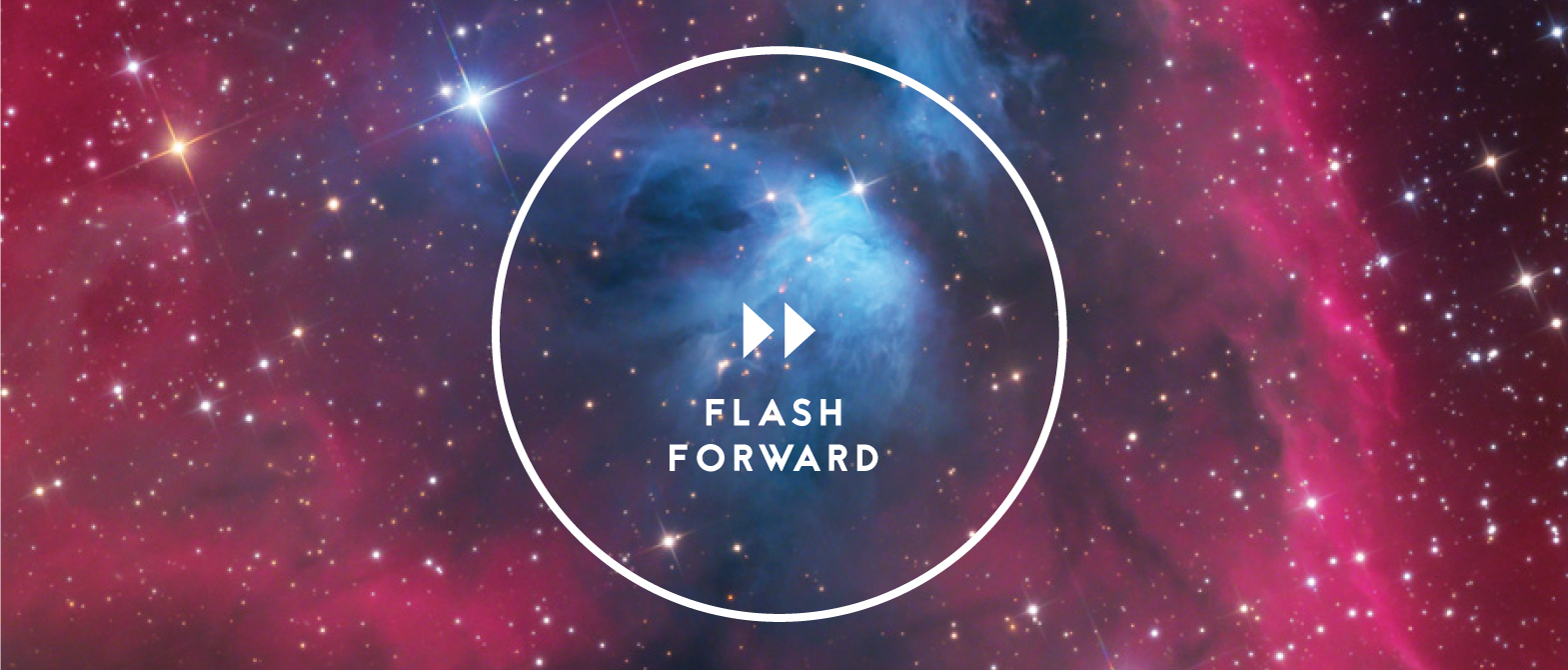
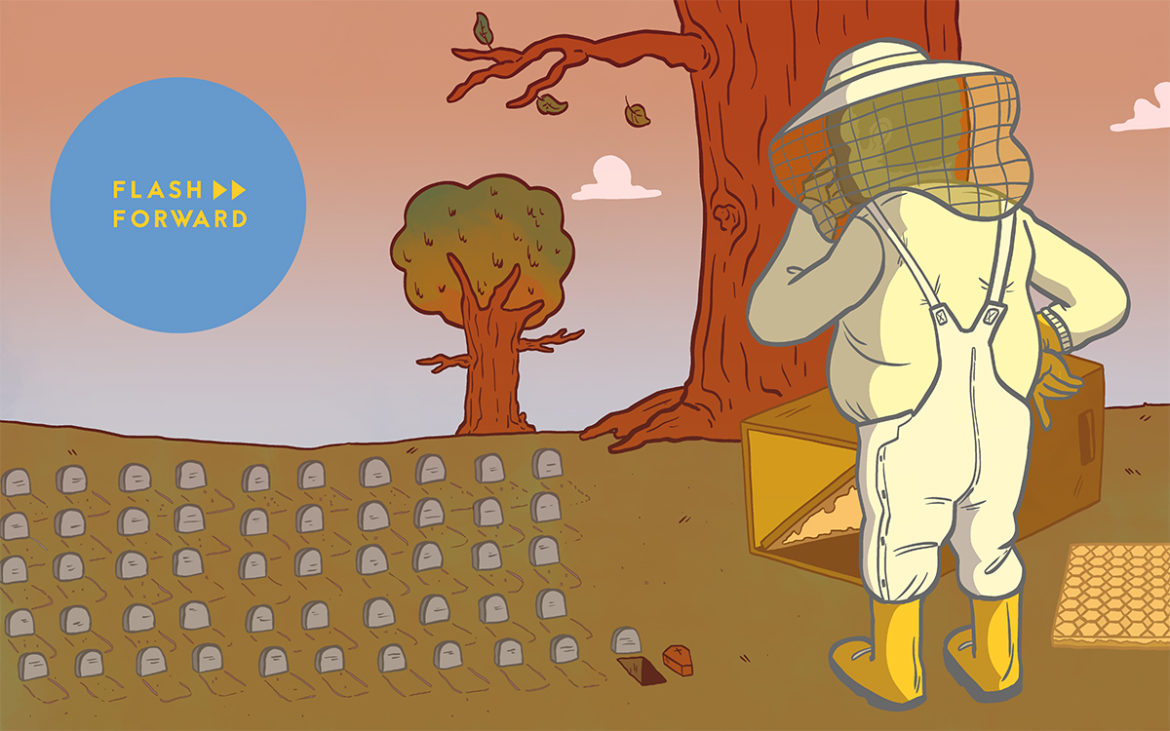
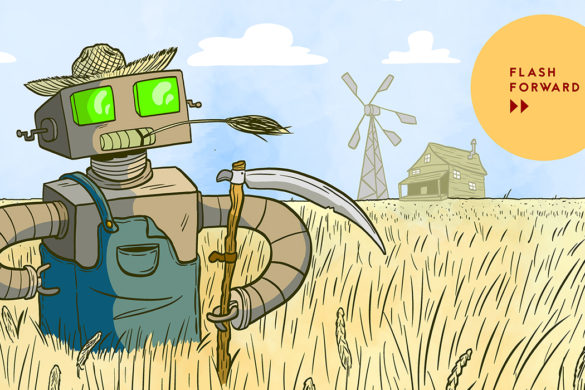
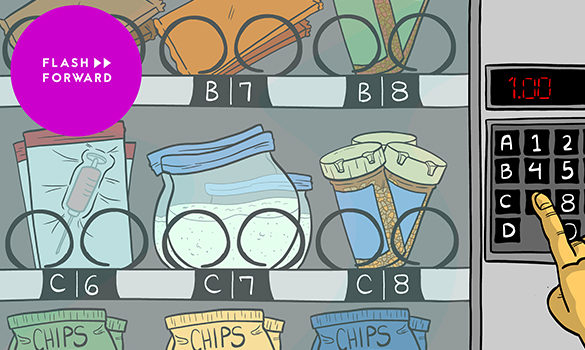
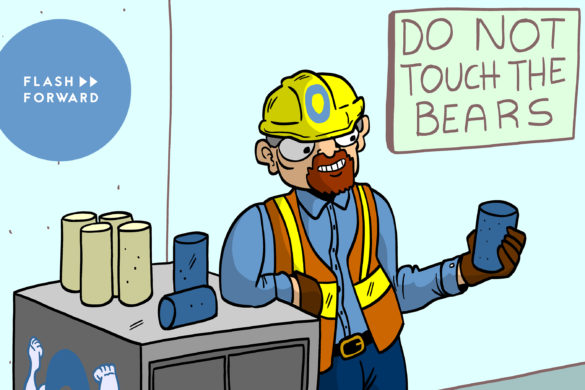
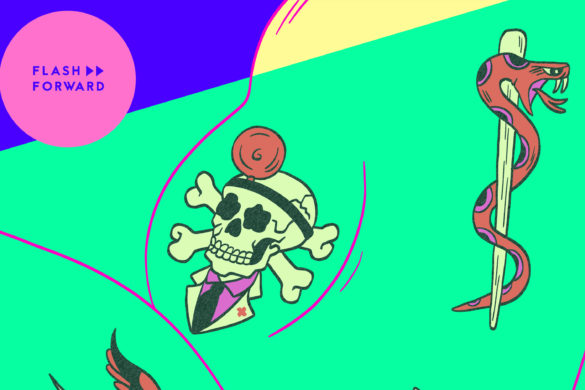
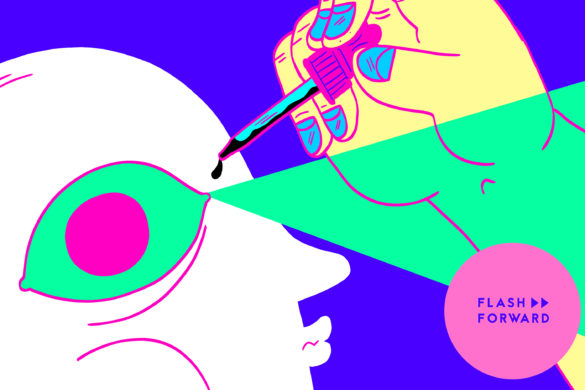
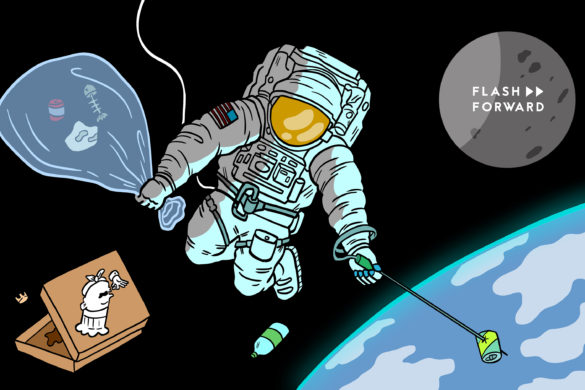
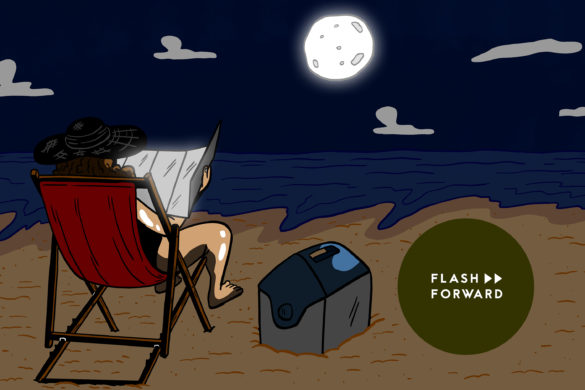
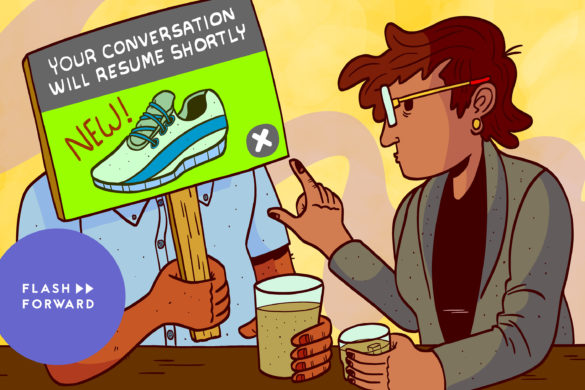
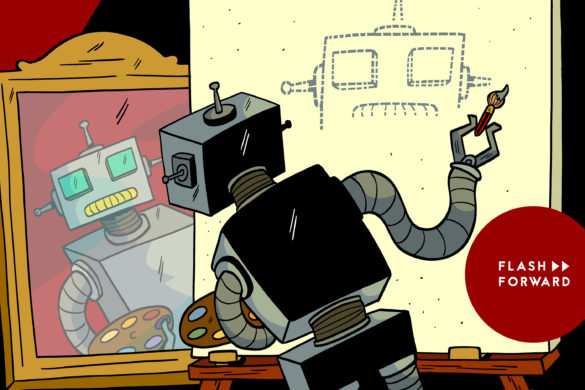
4 comments
I always like it to hear Mike in the opening stories.
Great episode!
[…] Buzz Off […]
[…] [Flash Forward] Buzz Off Apparently a world without bees won’t be the end of the world (although I’m still in favour of supporting our black-and-yellow companions). […]
The Future Is Now!!! Millions of genetically modified mosquitoes have been approved for release in Florida.
https://www.genomeweb.com/scan/millions-mosquitoes